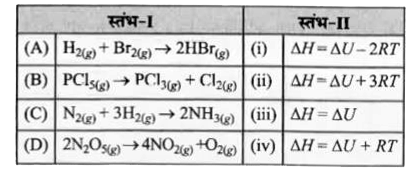Match the transformations in Column I with appropriate options in Column II
 Solution in Malayalam
Solution in Malayalam
p,r,sB=r,sC,tD−q,r,t
CO2(s)→CO2(g),ΔH=+ve, phaase transition and ΔS=+ve.
CaCO3(s)→CaO(s)+CO2(g),ΔH=+ve, no phas etransition and ΔS=+ve.
2H(g)→H2(g), Two particles given one gaseous partice, so ΔS=−ve.
P (white , solid) → P ( red solide), ΔH=+ve,ΔS=−ve, altotropic change, that is , phosphrous is getting changed from oen allotope form into another
Topper's Solved these Questions
- CHEMICAL THERMODYNAMICS BOOK - BRILLIANT PUBLICATIONCHAPTER - CHEMICAL THERMODYNAMICS EXERCISE - LEVEL-II (Assertion-Reason Type)
18 Videos
- CHEMICAL BONDING AND MOLECULAR STRUCTUREBOOK - BRILLIANT PUBLICATIONCHAPTER - CHEMICAL BONDING AND MOLECULAR STRUCTUREEXERCISE - QUESTION (LEVEL -ll)
42 Videos
- CLASSIFICATION OF ELEMENTS AND PERIODICITY IN PROPERTIESBOOK - BRILLIANT PUBLICATIONCHAPTER - CLASSIFICATION OF ELEMENTS AND PERIODICITY IN PROPERTIESEXERCISE - QUESTIONS (LEVEL-III ( Linked Comprehension Type ))
12 Videos
Similar Questions
Assertion : Heat of neutralisation of HNO3, and NaOH is almost same as that of HCl and KOH.
Reason : Both HNO3, and HCl are strong acids and NaOH and KOH are strong bases. : if both (A) and (R) are correct and (R) is the correct explanation of(A)., If both (A) and (R) are correct, but (R) is not the correct explanation of(A)., If(A) is correct, but (R) is incorrect., If both (A) and (R) are incorrect.
View SolutionWhich of the following species are hypervalent ?
(l) ClO−4
(ll) BF3
(lll) SO2−4
(lV) CO2−3
View SolutionThe heats of formation (ΔH∘f) of the oxides of the third period, sodium to chlorine, are in kJ mol−1

Based on these data, answer the following questions
Which oxide has maximum negative heat of formation per oxygen atom?
View SolutionMatch the transformations In column I with appropriate options in column II.

View SolutionMatch the transformation in column I with appropriate options in column II
View Solutionस्तंभ-I को स्तंभ-II से मिलान करें तथा उचित विकल्प को चिन्हित करें।

View Solutionस्तंभ-I को स्तंभ-II से मिलाइए तथा उचित विकल्प को चिन्हित कीजिए।

View Solutionस्तंभ-I को स्तंभ-II से मिलान करें तथा उचित विकल्प को चिन्हित करें।

View Solutionस्तंभ-I को स्तंभ-II से मिलान करें तथा उचित विकल्प को चिन्हित करें।

View Solutionस्तंभ-I को स्तंभ-II से मिलान करें तथा उचित विकल्प पर निशान लगाएं।

View Solutionस्तंभ-I को स्तंभ-II से मिलान करो तथा उचित विकल्प पर निशान लगाएं।

View Solutionस्तंभ-I को स्तंभ-II से मिलान करें तथा उचित विकल्प पर निशान लगाएं।

View Solutionस्तंभ-I को स्तंभ-II से मिलान करें तथा उचित विकल्प पर निशान लगाएं।

View Solutionस्तंभ-I को स्तंभ-II से मिलान करें तथा उचित विकल्प पर निशान लगाएं।

View Solutionस्तंभ-I को स्तंभ-II से मिलान करें तथा उचित विकल्प पर निशान लगाएं।

View Solutionस्तंभ-I को स्तंभ-II से मिलान करें तथा उचित विकल्प को चिन्हित करें।

View Solution
